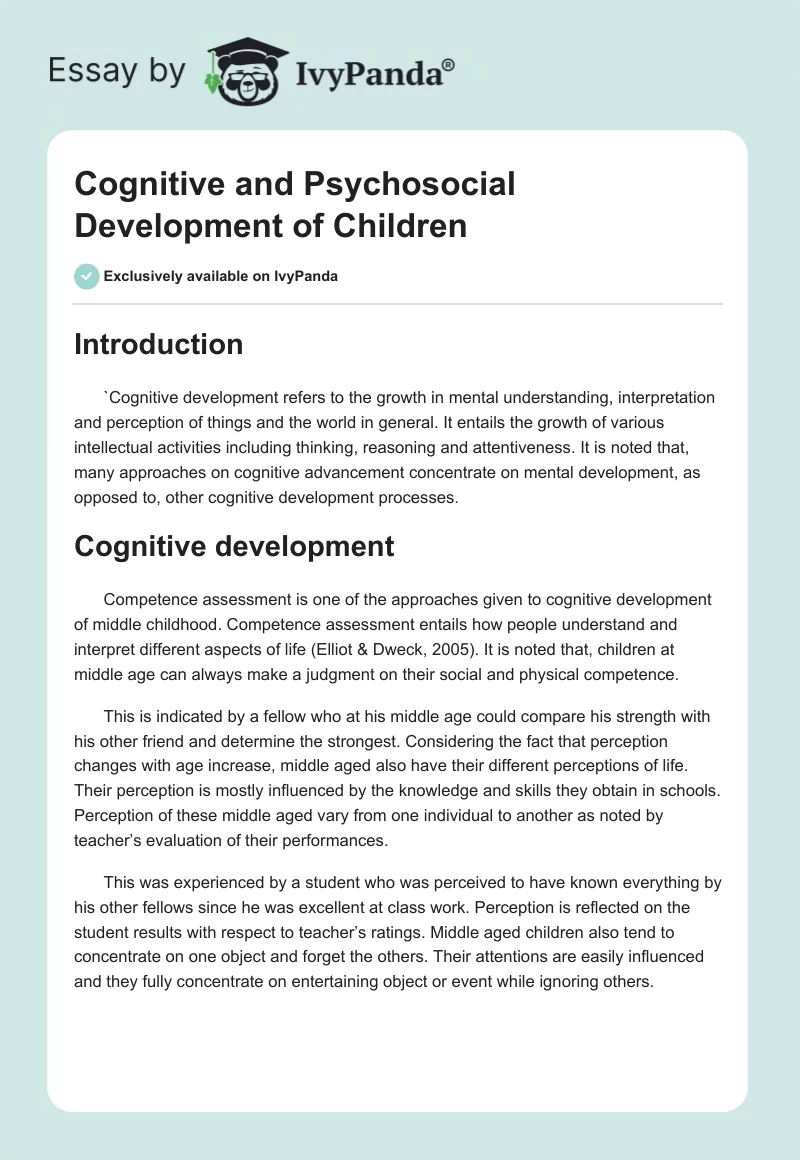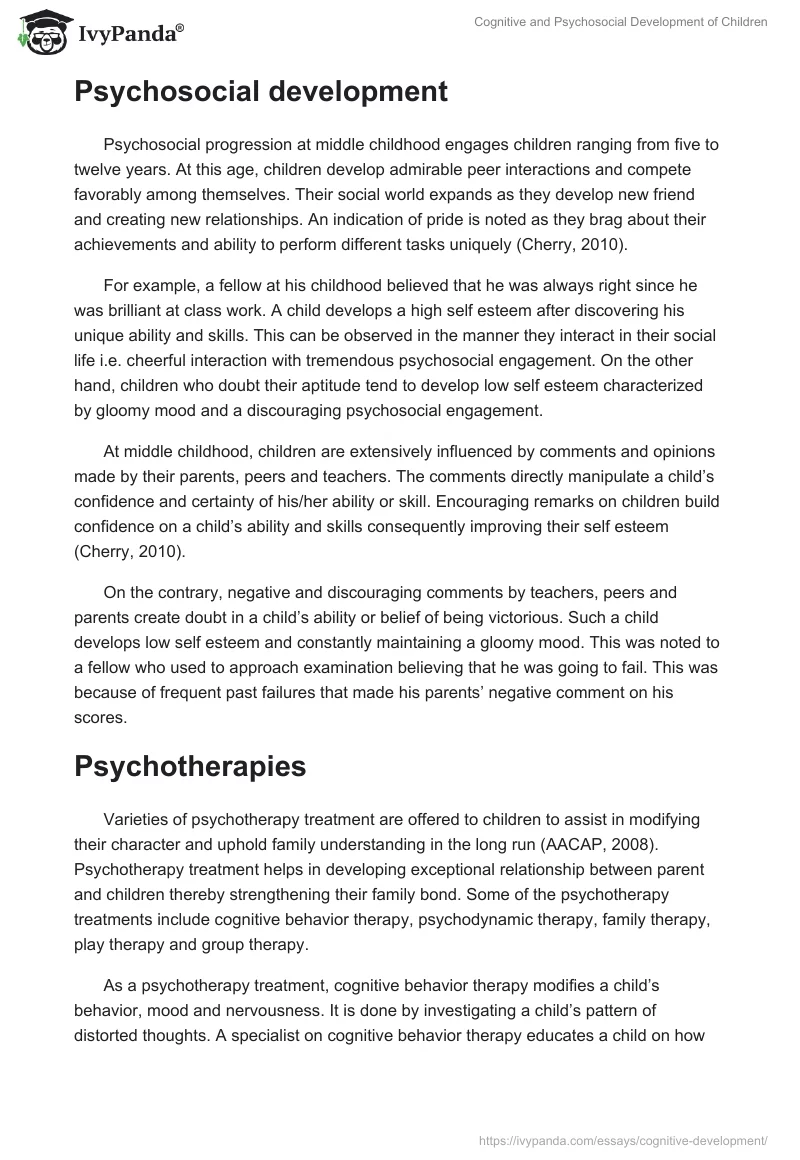Introduction
`Cognitive development refers to the growth in mental understanding, interpretation and perception of things and the world in general. It entails the growth of various intellectual activities including thinking, reasoning and attentiveness. It is noted that, many approaches on cognitive advancement concentrate on mental development, as opposed to, other cognitive development processes.
Cognitive development
Competence assessment is one of the approaches given to cognitive development of middle childhood. Competence assessment entails how people understand and interpret different aspects of life (Elliot & Dweck, 2005). It is noted that, children at middle age can always make a judgment on their social and physical competence.
This is indicated by a fellow who at his middle age could compare his strength with his other friend and determine the strongest. Considering the fact that perception changes with age increase, middle aged also have their different perceptions of life. Their perception is mostly influenced by the knowledge and skills they obtain in schools. Perception of these middle aged vary from one individual to another as noted by teacher’s evaluation of their performances.
This was experienced by a student who was perceived to have known everything by his other fellows since he was excellent at class work. Perception is reflected on the student results with respect to teacher’s ratings. Middle aged children also tend to concentrate on one object and forget the others. Their attentions are easily influenced and they fully concentrate on entertaining object or event while ignoring others.
Psychosocial development
Psychosocial progression at middle childhood engages children ranging from five to twelve years. At this age, children develop admirable peer interactions and compete favorably among themselves. Their social world expands as they develop new friend and creating new relationships. An indication of pride is noted as they brag about their achievements and ability to perform different tasks uniquely (Cherry, 2010).
For example, a fellow at his childhood believed that he was always right since he was brilliant at class work. A child develops a high self esteem after discovering his unique ability and skills. This can be observed in the manner they interact in their social life i.e. cheerful interaction with tremendous psychosocial engagement. On the other hand, children who doubt their aptitude tend to develop low self esteem characterized by gloomy mood and a discouraging psychosocial engagement.
At middle childhood, children are extensively influenced by comments and opinions made by their parents, peers and teachers. The comments directly manipulate a child’s confidence and certainty of his/her ability or skill. Encouraging remarks on children build confidence on a child’s ability and skills consequently improving their self esteem (Cherry, 2010).
On the contrary, negative and discouraging comments by teachers, peers and parents create doubt in a child’s ability or belief of being victorious. Such a child develops low self esteem and constantly maintaining a gloomy mood. This was noted to a fellow who used to approach examination believing that he was going to fail. This was because of frequent past failures that made his parents’ negative comment on his scores.
Psychotherapies
Varieties of psychotherapy treatment are offered to children to assist in modifying their character and uphold family understanding in the long run (AACAP, 2008). Psychotherapy treatment helps in developing exceptional relationship between parent and children thereby strengthening their family bond. Some of the psychotherapy treatments include cognitive behavior therapy, psychodynamic therapy, family therapy, play therapy and group therapy.
As a psychotherapy treatment, cognitive behavior therapy modifies a child’s behavior, mood and nervousness. It is done by investigating a child’s pattern of distorted thoughts. A specialist on cognitive behavior therapy educates a child on how their moods and behavior are influenced by their thoughts (AACAP, 2008). Subsequently, a child develops a skill of recognizing these hazardous thoughts.
The specialist also helps the child to substitute these harmful thoughts with constructive and positive thoughts. It is renowned that cognitive therapy test has helped in treating various types of disorders anxiety being one of them. A friend’s confirmed of psychotherapeutic help in alleviating her selfish behavior of forcefully snatching other children’s food, toys and never shared his possessions with others.
The next psychotherapy cure is play therapy, a treatment that entails the understanding of how children play with toys, drawings and dolls. At children’s play time, a therapist notes some of the feelings and expressions of a child and uses them to perform the therapy (AACAP, 2008).
It is essential to note that observations are done on how a child plays with the toys for better understanding of the child’s problem. Afterwards, the therapist educates a child how to handle their problems and during play time. This was reflected by a fellow who used to smack his colleagues using toy but fortunately, a therapist rescued him from his intolerable behavior.
Also, psychodynamic psychotherapy can be employed in correcting a child’s feelings and thoughts. It entails the recognition of the factors that influence a child’s feeling and thoughts. This helps the therapist to understand the reasons (inner struggles) as to why a child is behaving in a certain manner. Consequently, the child is subjected to different weekly session of psychoanalysis.
Conclusion
Cognitive development applies to every individual and keeps on varying with an increase in age. Individuals experience changes in life perceptions, understanding and interpretations.
However, some children perceive and understand life in a negatively thus making them portray unpleasant and discouraging behaviors. Fortunately, these obnoxious behaviors can be corrected by employing different psychotherapies that eventually improves a child’s perception and behavior.
References
American academy of child and adolescent psychiatry (AACAP). (2008). Psychotherapies for children and adolescents. Washington: American academy of child and adolescent psychiatry. Web.
Cherry, K. (2010), Stages of psychosocial development. About.com: psychology. Web.
Elliot, J. & Dweck, S. (2005). Handbook of competence and motivation. New York: Guilford press.


